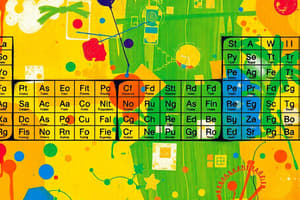Podcast
Questions and Answers
Which gas makes up approximately 78% of the Earth's atmosphere?
Which gas makes up approximately 78% of the Earth's atmosphere?
- Argon
- Oxygen
- Nitrogen (correct)
- Carbon dioxide
What would be the approximate average temperature without the atmosphere surrounding the Earth?
What would be the approximate average temperature without the atmosphere surrounding the Earth?
- -20°C
- -250°C
- -100°C
- -190°C (correct)
Approximately what percentage of the Earth's atmosphere is composed of oxygen?
Approximately what percentage of the Earth's atmosphere is composed of oxygen?
- 78%
- 21% (correct)
- ~0.04%
- 0.93%
What is the main function of the Earth's atmosphere with regard to energy balance?
What is the main function of the Earth's atmosphere with regard to energy balance?
Besides nitrogen, oxygen, and argon, what is another important component found in trace amounts in the Earth's atmosphere?
Besides nitrogen, oxygen, and argon, what is another important component found in trace amounts in the Earth's atmosphere?
What is the primary function of the ozone layer?
What is the primary function of the ozone layer?
Which layer of the Earth's atmosphere contains most of the ozone?
Which layer of the Earth's atmosphere contains most of the ozone?
At what approximate altitude does the mesosphere begin?
At what approximate altitude does the mesosphere begin?
Which sphere of the Earth is defined as the rock layer around the planet?
Which sphere of the Earth is defined as the rock layer around the planet?
In which atmospheric layer are gas particles hot during the day and cold at night?
In which atmospheric layer are gas particles hot during the day and cold at night?
What is the usual pattern of weather in a region over a long period of time called?
What is the usual pattern of weather in a region over a long period of time called?
Which factor is NOT considered as a main component affecting Earth's climate?
Which factor is NOT considered as a main component affecting Earth's climate?
Why do climatologists collect weather measurements made over 30 years or more?
Why do climatologists collect weather measurements made over 30 years or more?
What impact has less snow and increased warmth had on the Inuit way of life?
What impact has less snow and increased warmth had on the Inuit way of life?
How can people distinguish between yearly weather fluctuations and long-term climate change?
How can people distinguish between yearly weather fluctuations and long-term climate change?
Which environmental factor has NOT been observed by the Inuit regarding climate change?
Which environmental factor has NOT been observed by the Inuit regarding climate change?
Flashcards are hidden until you start studying
Study Notes
Composition of the Earth's Atmosphere
- Nitrogen makes up approximately 78% of the Earth's atmosphere.
- Oxygen composes approximately 21% of the Earth's atmosphere.
- Argon is another important component found in trace amounts in the Earth's atmosphere.
Atmosphere and Energy Balance
- The main function of the Earth's atmosphere is to regulate energy balance.
Ozone Layer
- The primary function of the ozone layer is to protect the Earth from harmful ultraviolet radiation.
- The stratosphere is the layer of the Earth's atmosphere that contains most of the ozone.
Atmospheric Layers
- The mesosphere begins at an approximate altitude of 50 km.
- The thermosphere is the atmospheric layer where gas particles are hot during the day and cold at night.
Spheres of the Earth
- The lithosphere is the rock layer around the planet.
Climate and Weather
- The usual pattern of weather in a region over a long period of time is called climate.
- Climatologists collect weather measurements made over 30 years or more to distinguish between yearly weather fluctuations and long-term climate change.
- Human activity is a main component affecting Earth's climate.
Climate Change and the Inuit
- Less snow and increased warmth have impacted the Inuit way of life.
- The Inuit have observed changes in sea ice, glaciers, and migratory patterns of animals as environmental factors of climate change.
- The Inuit have not observed changes in the Earth's magnetic field as a factor of climate change.
Studying That Suits You
Use AI to generate personalized quizzes and flashcards to suit your learning preferences.



